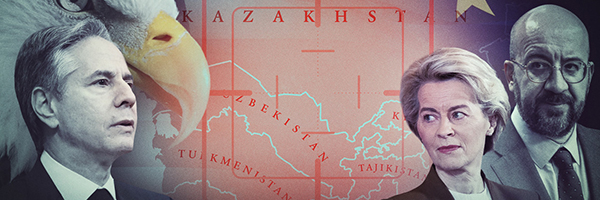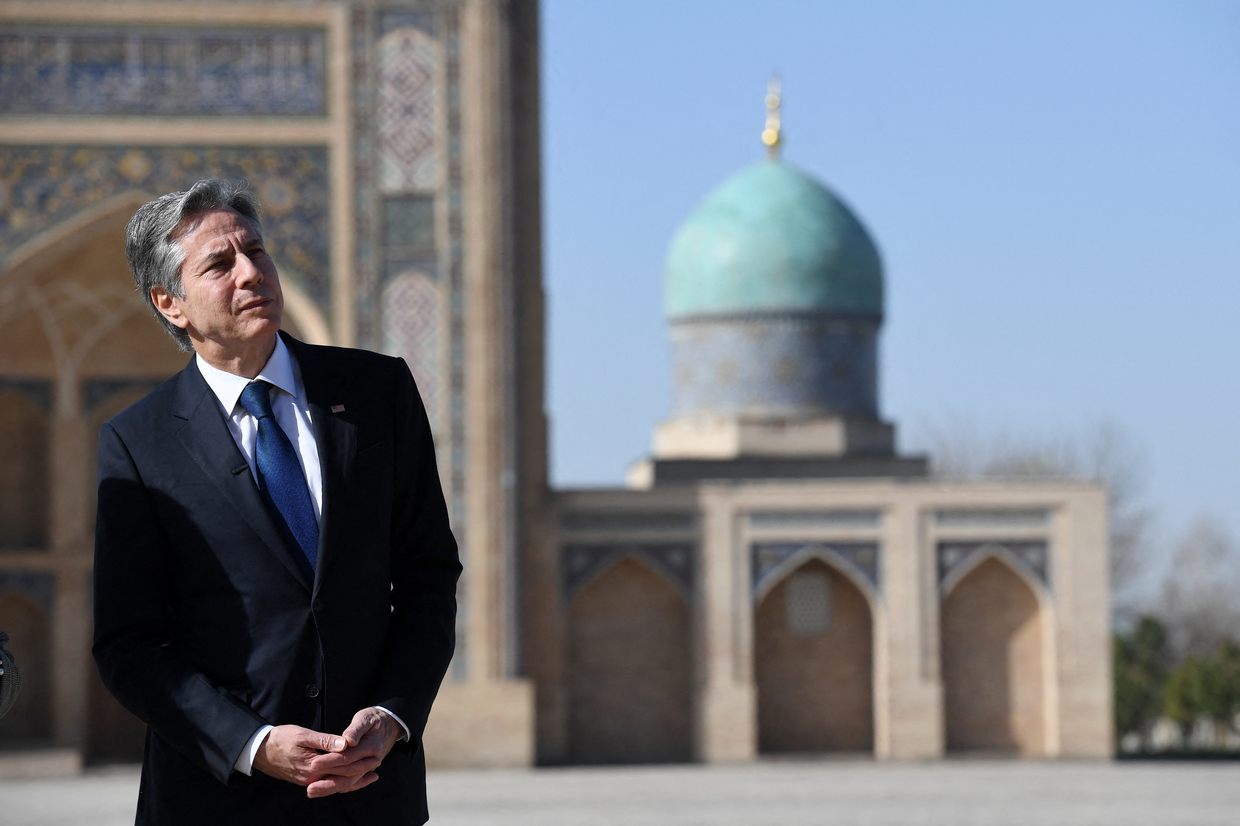Taking a dagger to the ‘soft underbelly’: How the West has opened yet another front against Russia
 RT, June 28, 2023 —
RT, June 28, 2023 —
In the first half of 2023, both the European Union and the United States were noticeably active in Central Asia – which is regarded by some as Russia’s “soft underbelly.” Many Western European and American politicians and diplomats frequented the region and attempted to pull the ex-Soviet republics of Kazakhstan, Tajikistan, Uzbekistan, Kyrgyzstan, and Turkmenistan over to their side in the ongoing conflict with Moscow.
The West wants to convince those states to support sanctions on Russia and block parallel imports to the country. It has promised compensation for financial losses. Moreover, Western European leaders see the likes of Kazakhstan as a source of natural resources that could potentially replace Moscow.
With all this recent attention, Central Asia is becoming increasingly aware of its own political importance – but will this lead it to break ties with Russia, as the West hopes?
Frequent guests
Last week, the 10th EU-Central Asia High-Level Political Dialogue was held in Astana, the capital of Kazakhstan. This rather minor diplomatic event was devoted to creating roadmaps for the resolutions adopted at the much larger summit attended by Central Asian leaders and the President of the European Council, and held in the Kyrgyz city of Cholpon-Ata in early June.
Over the past year, visits by the President of the European Council Charles Michel to Central Asia – a region which until recently has been of very little interest to Brussels – have become regular. The very first EU-Central Asia summit attended by the Belgian took place in Kazakhstan less than a year ago, in October 2022 – just eight months after the start of Russia’s offensive in Ukraine. The next summit involving the leadership of the EU and the five Central Asian countries will take place in Uzbekistan next year.
It may look like this year’s event is a response to the inaugural China-Central Asia Summit held in Xi’an in the second half of May. But in fact, Beijing seems to be lagging behind its Western European competitors who held the EU-Central Asia Economic Forum in the city of Almaty, Kazakhstan, at the same time. Their was attended by high-ranking representatives of their governments – along with people from the European Investment Bank, the European Bank for Reconstruction and Development, the OECD, and private organizations. Kazakhstan, Kyrgyzstan, and Tajikistan were represented by their heads of government, the Uzbek delegation was headed by the deputy prime minister, and the Turkmen delegation was led by the minister of finance and economy.
Representatives of the US State Department have also made a considerable number of trips to Central Asia. In February,Secretary of State Antony Blinken visited Kazakhstan and Uzbekistan. His assistants at the Bureau of South and Central Asian Affairs, Donald Lu and Uzra Zeya have also been frequent guests in the region. In March, EU Sanctions Envoy David O’Sullivan visited Kyrgyzstan. In April, he made a working visit to Kazakhstan and Uzbekistan accompanied by Elizabeth Rosenberg, Assistant Secretary for Terrorist Financing and Financial Crimes at the US Department of the Treasury.
Interaction between Washington and Central Asia mainly occurs within the framework of the “C5+1” format. It originated in 2015, when former US Secretary of State John Kerry launched a dialogue at the level of the foreign ministers of five Central Asian countries and Washington. Since then, meetings between the US State Department and these countries have been held annually.

The purpose of this cooperation is no secret to anyone. From the project’s earliest days, pro-Western media in Kazakhstan admitted that it is “more of a ‘1 + C5’ format” and is “another structure proposed by an external player seeking to bring the Central Asian states under its orbit of influence.”
But why have contacts between the West and Central Asia become so frequent and regular recently?
Old ties, new goals
After the start of Russia’s military offensive in Ukraine, in February of last year, the US and the EU introduced several packages of sanctions against Moscow, including restrictions on the import of hundreds of goods from Western countries. In response to the restrictions, the Russian authorities legalized parallel imports – i.e., without the permission of the trademark owner. Such trade rom Russia’s neighboring countries increased a hundredfold and by the end of last year, 2.4 million tons of goods worth over $20 billion had been brought into the country using this mechanism.
According to Kazakhstan’s edition of Forbes, exports from the country to Russia rose by 25% last year compared to 2021. The Financial Times indicates that the number of washing machines exported from Kazakhstan to Russia rose from zero in 2021 to 100,000 in 2022. The export of computer equipment, monitors, and projectors amounted to $375.4 million, and shipments increased more than 400 times over the past year, a Kazakh journalist reported.
At the end of April, speaking at an exhibition in the capital of Uzbekistan, Russian Minister of Industry and Trade Denis Manturov noted that the trade turnover between Russia and Central Asia had increased by 15% last year and amounted to over $42 billion. Central Asia is one of the world’s leading regions when it comes to the growth of trade with Russia. For example, trade turnover with Uzbekistan has grown by more than 25%.
It is impossible to say that this growth is only due to parallel imports. However, such a surge has never been observed previously.



